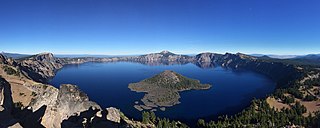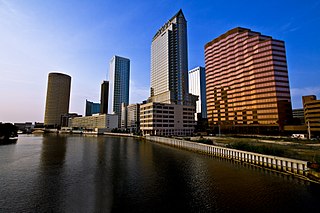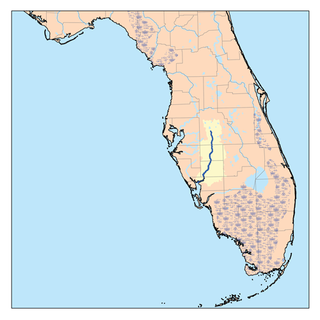
Hillsborough County is located in the west central portion of the U.S. state of Florida. In the 2020 census, the population was 1,459,762, making it the fourth-most populous county in Florida and the most populous county outside the Miami metropolitan area. A 2021 estimate has the population of Hillsborough County at 1,512,070 people with a yearly growth rate of 1.34%, which itself is greater than the populations of 12 states according to their 2019 population estimates. Its county seat and largest city is Tampa. Hillsborough County is part of the Tampa–St. Petersburg–Clearwater Metropolitan Statistical Area.

FishHawk is an unincorporated area and census-designated place (CDP) in Hillsborough County, Florida, United States. It is a suburb of Tampa, Florida, and includes a portion of the community of Lithia. As of the 2010 census, the CDP had a population of 14,087, up from 1,991 at the 2000 census. The place name is derived from Little Fishhawk Creek, a tributary of the Alafia River that joins the Alafia just west of Lithia Springs.

Riverview is an unincorporated census-designated place in Hillsborough County, Florida, United States. It is located south of Brandon. The population was 107,396 in the 2020 census, up from 71,050 in the 2010 census.

Crater Lake National Park is an American national park located in southern Oregon. Established in 1902, Crater Lake is the fifth-oldest national park in the United States and the only national park in Oregon. The park encompasses the caldera of Crater Lake, a remnant of Mount Mazama, a destroyed volcano, and the surrounding hills and forests.

The Hillsborough River is a river located in the state of Florida in the United States. It arises in the Green Swamp near the juncture of Hillsborough, Pasco and Polk counties, and flows 60 miles (97 km) through Pasco and Hillsborough Counties to an outlet in the city of Tampa on Tampa Bay. It includes 4 nature trails extending for over 7 miles (11 km), making it perfect for hikers. The name Hillsborough River first appeared on a British map in 1769. At the time, the Earl of Hillsborough was the British Secretary of State for the Colonies, and thus controlled the pensions of the surveyors working in the American colonies, which included East Florida.

Lithia is an unincorporated community in Hillsborough County, Florida, United States. It is a suburb of Tampa. The ZIP codes are 33547, 33596, and the area code is 813. It is part of the census-designated place (CDP) of Fish Hawk. Lithia is home to the 2,963-acre (1,199 ha) Alafia River Corridor and 5,515-acre (2,232 ha) Chito Branch Reserve.

Ichetucknee Springs State Park is a 2,241-acre (9.07 km2) Florida State Park and National Natural Landmark located 4 miles (6 km) northwest of Fort White off State Road 47 and State Road 238. It centers around the 6-mile-long (10 km) Ichetucknee River, which flows through shaded hammocks and wetlands into the Santa Fe River. The park contains hardwood hammock and limestone outcrops. Like many rivers in this part of North Florida, the Ichetucknee is fed by natural springs which boil up from the aquifer. The state of Florida purchased the property in 1970 from the Loncala Phosphate Corporation for $1,850,000.

The Alafia River is 25 miles (40 km) long, with a watershed of 335 square miles (870 km2) in Hillsborough County, Florida, United States, flowing into Tampa Bay. The watershed contains ten named lakes and ponds, and 29 named rivers, streams and canals. During the rainy season, excess water is pumped to the new C.W. Bill Young Regional Reservoir, which opened in 2005. The river is formed by two prongs. The north prong starts south of Mulberry and runs for 23.9 miles until it meets the south prong in Lithia. The south prong begins south of Bradley Junction and continues for 28.7 miles. The combined river then flows 24.7 miles west into Tampa Bay.
Alafia River State Park is a Florida State Park, located near Picnic in Hillsborough County in central Florida, 17 miles southeast of Tampa on County Road 39. Even before it became a park, the area, and particularly Hurrah Lake, was the center of leisure activities since the early 1880s.

The Southwest Florida Water Management District, is one of five regional agencies directed by Florida state law to protect and preserve water resources. Established in 1961 the agency operates and maintains several large properties and flood protection projects, sometimes with other agencies. The District's responsibilities have expanded to include managing water supply and protecting water quality and the natural systems — rivers, lakes, wetlands and associated uplands.The District's stated mission is to protect water resources, minimize flood risks and ensure the public’s water needs are met.

Crystal River is a very short river in Citrus County, Florida, flowing into the Gulf of Mexico. It is just seven miles long, and has a drainage basin of five square miles, joining Kings Bay to the Gulf of Mexico. The river's significance is in the thirty natural springs that add an average of 300 million gallons of warm water to the river every day. These springs include Three Sisters Springs.
Edward Medard Park and Preserve, originally known as Pleasant Grove Reservoir Park, is located south of Plant City, Florida, on Turkey Creek Road in Hillsborough County, Florida. The 1,284-acre (5.20 km2) park just north of Durant, Florida was the site of phosphate mining in the 1960s by the American Cyanamid Company, before the land was donated. A dike and 770-acre (3.1 km2) reservoir were created in 1970 to provide flood protection along the Alafia River. The lake has a very extensive and irregular shoreline, and great variation is found in the lake bottom as well. The park is maintained by the Hillsborough County Parks and Recreation Department, and has camping, picknicking, and other facilities. Three long piers offer the ability to launch fairly large vessels, although the lake has a no-wake restriction. Additional opportunities for various sports and aquatic activities are available at the popular spot which attracts approximately 250,000 visitors a year.
According to the Natural Resources Defense Council's recent study, Florida is one of 14 states predicted to face "high risk" water shortages by the year 2050. The state's water is primarily drawn from the Floridan Aquifer as well as from the St. Johns River, the Suwannee River, and the Ocklawaha River. Florida's regional water conflicts stem primarily from the fact that the majority of the fresh water supply is found in the rural north, while the bulk of the population, and therefore water consumption, resides in the south. Metropolitan municipalities in central and south Florida have neared their aquifer extraction limit of 650 million US gallons (2,500,000 m3) per day, leading to the search for new, extra-regional sources.

Kissingen Spring was a natural spring formerly flowing in Polk County, Southwest Florida. It was also a venue for recreation until it dried up in 1950. Hundreds of wells drilled into the Floridan Aquifer may have caused the demise of the springs. Its site is located near the northern end of Peace River, approximately 3/4 mile east of U.S. Highway 17 and 4 miles south of Florida SR 60 / south of Bartow.
The Balm-Boyette Scrub Nature Preserve is a 5,723-acre (2,316 ha) preserve located in Hillsborough County, Florida. It was purchased through joint funding from the County's Environmental Lands Acquisition and Protection Program (ELAPP) and the State of Florida's Conservation and Recreation Lands (CARL) Program. While it consists largely of abandoned phosphate pits, it has a large area of undisturbed scrub habitat. Natural habitats within the site include sand pine scrub, xeric oak scrub, pine flatwoods, hardwood hammock, wet prairie, freshwater marsh, cypress swamp, and hardwood swamp. During the 1960s the land was pitted with phosphate mines. The natural waterflow had been altered from its original state into a series of stagnant pools. In 2016, a project was undertaken under the umbrella of Swiftmud's Surface Water Improvement and Management, or SWIM, program. The project will create a "habitat mosaic" with habitat for wading birds as well as upland creatures.
Fish Hawk Creek Nature Preserve is a 3,286-acre (1,330 ha) nature preserve in Hillsborough County, Florida. The preserve is managed by Hillsborough County's Conservation and Environmental Lands Management Department and is located along the riparian corridor of FishHawk Creek, a significant tributary of the Alafia River. As a result, the acquisition and protection of the Fish Hawk Creek Nature Preserve has provided an essential link in assuring the long-term protection of a significant regional habitat corridor. Restoration projects have been initiated on the property. Habitats include pine flatwoods, sandhill, Florida scrub, and creek corridors. The preserve is bisected by FishHawk Blvd. and is identified by a north and a south section. The north section of the preserve includes a 2.2 mile hiking trail and can be accessed through Lithia Springs Regional Park in Lithia, Florida. The south portion of the preserve can be accessed through a parking area near the intersection of Boyette Rd. and Balm Rd. and includes a 2-mile hiking trail.
Alafia River Corridor Nature Preserve is a 4,700 acre area of protected lands in Hillsborough County, Florida. There are two trailheads for the preserves's hiking trails, one located at the north boundary of the Pinecrest Sports Complex on Hwy. 39 approximately one mile north of Hwy. 640 and one located on Hwy. 39 just north of Jameson Rd.

Greater Tampa Bay Area Council serves Scouts in West-Central Florida with the council headquarters in Tampa, Florida. Youth are served in the following nine counties: Citrus, Hardee, Hernando, Highlands, Hillsborough, Pasco, Pinellas, Polk and Sumter. Greater Tampa Bay Area Council was formed on May 1, 2016 by the merger of Gulf Ridge Council with West Central Florida Council.
Alderman's Ford Preserve, is a preserve and park in Hillsborough County, Florida, in the United States. The park has two public access points for automobiles, from Thompson Road and from Florida State Road 39 as well as numerous access points for horse, foot or canoe access only. Eight miles of equestrian trails are located along the southern portion of the park, which borders Alafia River State Park roughly along the border of Jameson Road. A three mile long hiking loop over the Alafia River, a baseball park, picknicking and canoe rental facilities can be accessed at the Highway 39 entrance.
Mud Hole Spring is an unusual warm-water, submarine discharge of water off the southwestern Gulf Coast of Florida, at 26°15′51″N82°01′02″W, approximately 18.5 kilometres (11.5 mi) south of the Sanibel Island Light and Lee County, Florida. It discharges geothermally warmed and turbid water from the sea floor.













